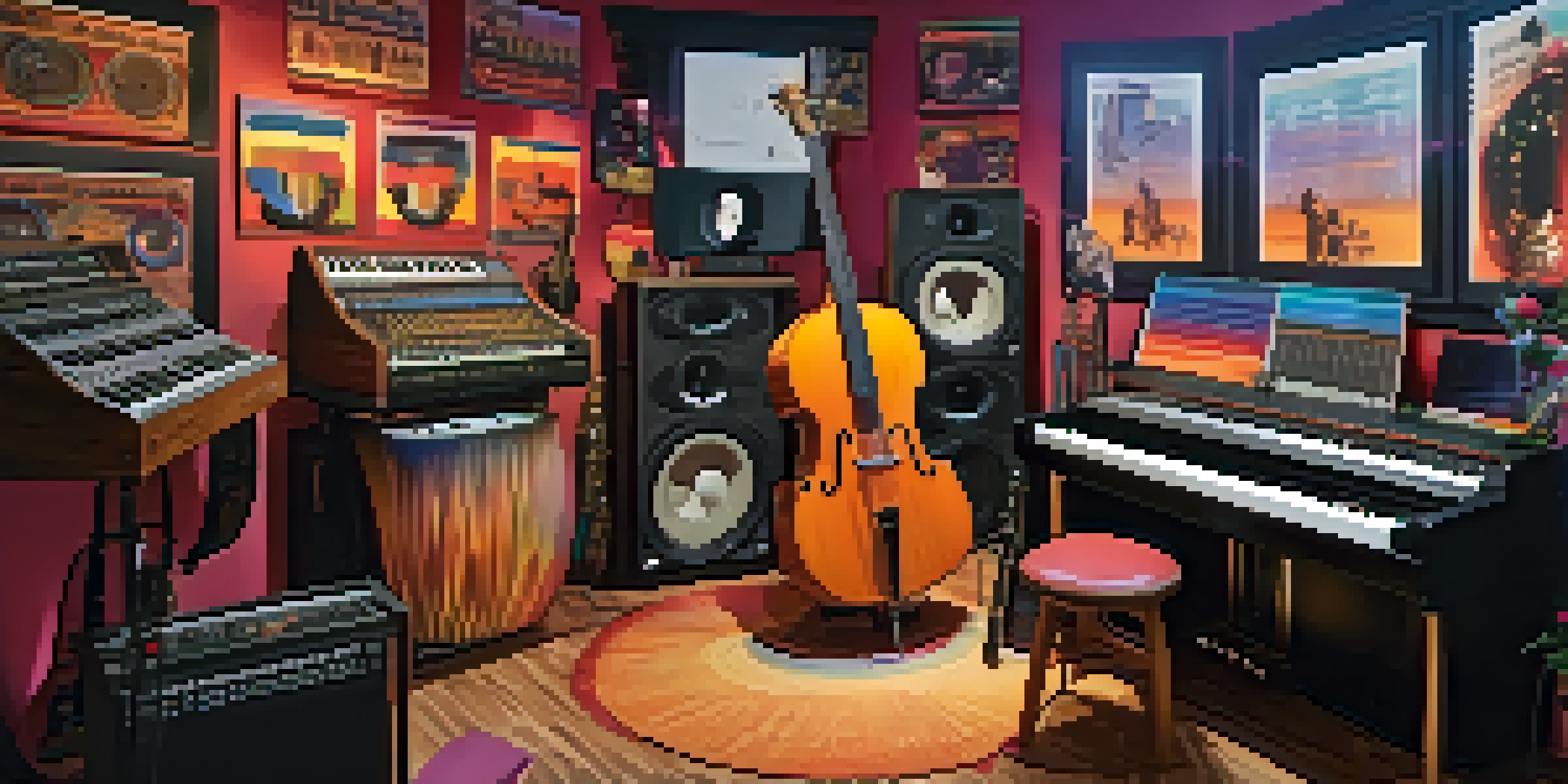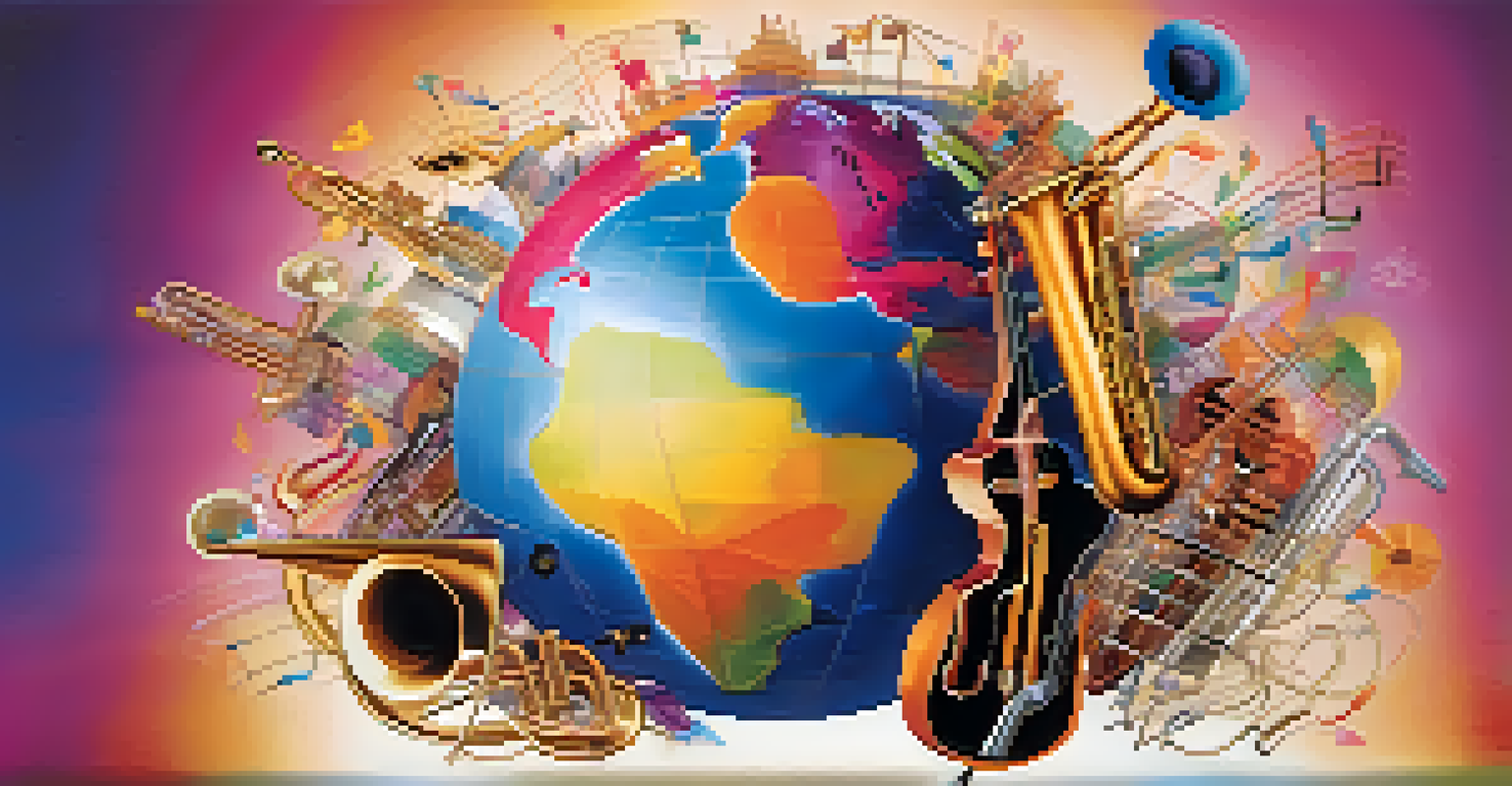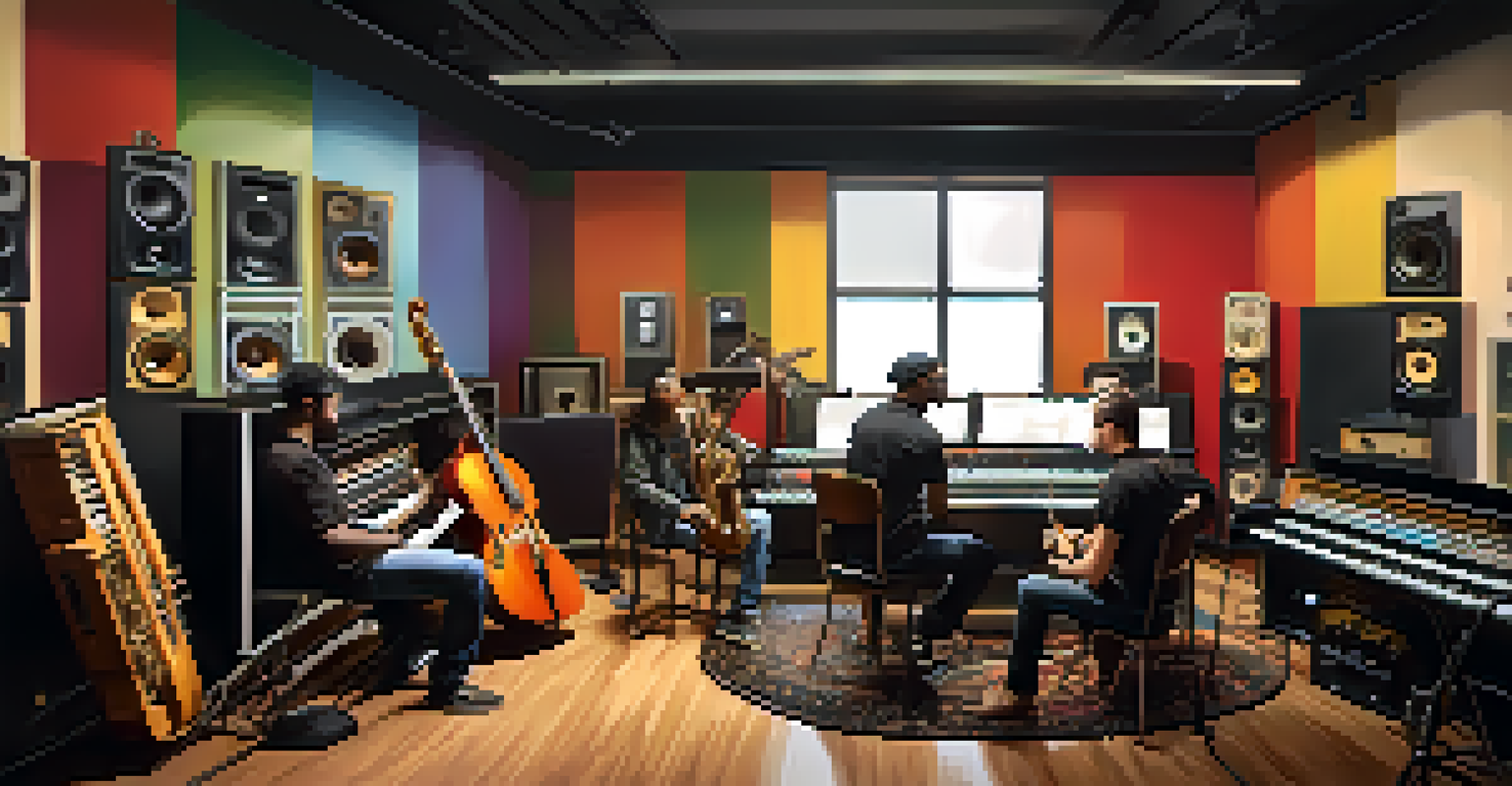Music Sampling and Globalization: A Cultural Exchange

Understanding Music Sampling: A Brief Overview
Music sampling is the practice of taking a portion of a sound recording and reusing it in a different song or piece of music. This technique has roots in hip-hop but has expanded across genres, showcasing creativity and innovation in music production. Think of it like a chef borrowing spices from various cuisines to create a new, delicious dish.
Music is the universal language of mankind.
In the digital age, sampling has become increasingly accessible, allowing artists worldwide to blend influences and genres. The beauty of sampling lies in its ability to pay homage to original works while simultaneously creating something fresh and unique. This art form not only enriches music but also contributes to a vibrant cultural tapestry.
As artists sample each other’s work, they engage in a form of dialogue, bridging gaps between cultures and eras. This exchange fosters a deeper appreciation for diverse musical styles, illustrating how interconnected our world truly is. It highlights that music knows no boundaries, resonating with people from all walks of life.
The Role of Technology in Music Sampling
Technology has revolutionized the way music is produced and consumed, making sampling more prevalent than ever. Digital audio workstations (DAWs) and software provide tools that enable artists to manipulate sounds easily, creating a seamless integration of different musical elements. This democratization of music production means that anyone with a computer can experiment with sampling, regardless of their background.

Streaming platforms have also changed the landscape, allowing listeners to discover a diverse array of music from around the globe. As artists borrow from various cultures, they introduce their audiences to new sounds and styles, often leading to unexpected collaborations. This fusion of influences can result in innovative genres that captivate listeners.
Sampling: A Cultural Bridge
Music sampling serves as a powerful tool for cultural exchange, allowing artists to celebrate and share diverse influences.
Furthermore, social media has amplified the reach of sampled music, allowing trends to spread rapidly across borders. A catchy beat or hook can go viral, inspiring countless remixes and reinterpretations. This interconnectedness not only enriches the music scene but fosters cultural exchange on a global scale.
Cultural Exchange Through Sampling: A Two-Way Street
Sampling serves as a powerful tool for cultural exchange, allowing artists to share and celebrate their influences. When a musician samples a traditional sound from another culture, it can introduce that culture to a wider audience, creating awareness and appreciation. For example, when contemporary artists incorporate indigenous sounds, it helps preserve and highlight those musical traditions.
Sampling is an art form that allows us to pay homage to those who paved the way for us.
However, this exchange is not without its complexities. While many artists aim to honor the cultures they sample from, there can be instances of appropriation where the original context and significance are overlooked. This raises important questions about ownership and respect in the creative process, encouraging artists to engage thoughtfully with the cultures they draw from.
Ultimately, successful sampling requires a balance of creativity and cultural sensitivity. When done with intention, it can lead to a richer musical landscape that respects and amplifies diverse voices. The dialogue created through sampling can foster understanding and connection, breaking down cultural barriers in the process.
Legal Aspects: Copyright and Sampling
Navigating the legal landscape of music sampling can be tricky for artists. Copyright laws protect original works, meaning that using a sample without proper clearance can lead to legal disputes. This has led many artists to either seek permission or use samples that are in the public domain, ensuring they respect the rights of the original creators.
The rise of platforms offering sample packs and royalty-free sounds has made it easier for musicians to access materials without legal complications. These resources allow artists to experiment with new sounds while avoiding the risk of copyright infringement. This shift has democratized access to sampling, enabling more creators to participate in the cultural exchange.
Technology's Impact on Sampling
Advancements in technology have democratized music production, making sampling more accessible and fostering global collaboration.
Despite these developments, artists must still be aware of the ethical implications of sampling. Beyond legal permissions, it’s crucial to acknowledge and respect the cultural significance of the samples used. By doing so, artists can contribute positively to the ongoing dialogue around cultural exchange in music.
Influential Artists Who Pioneered Sampling
Several artists have made significant contributions to the art of sampling and have influenced its evolution in music. Pioneers like DJ Kool Herc and Grandmaster Flash were instrumental in popularizing sampling in hip-hop, using turntables to create innovative sounds that defined a genre. Their creativity laid the groundwork for countless artists who followed in their footsteps.
In the contemporary scene, artists like Kanye West and Pharrell Williams have pushed the boundaries of sampling, blending diverse influences to create chart-topping hits. Their ability to weave together disparate elements showcases the power of sampling as a tool for innovation and cultural exchange. By drawing from various genres, they create music that resonates with a global audience.
These artists exemplify how sampling can serve as a bridge between cultures, creating music that transcends geographical boundaries. Their work not only entertains but also sparks conversations about the interconnectedness of music and the importance of cultural appreciation. Through sampling, they remind us that music is a universal language.
The Future of Sampling in a Globalized World
As globalization continues to shape our cultural landscape, the future of music sampling looks promising. Artists are increasingly collaborating across borders, leading to the creation of hybrid genres that reflect our diverse world. This trend fosters a spirit of innovation and experimentation, encouraging musicians to draw inspiration from an even wider array of influences.
Emerging technologies, such as artificial intelligence and machine learning, are also set to transform the sampling landscape. These tools can analyze vast amounts of music, identifying patterns and suggesting samples that artists may not have considered. This opens up new avenues for creativity, pushing the boundaries of what is possible in music production.
Navigating Legal Aspects
Understanding copyright laws is crucial for artists sampling music, as they must balance creativity with respect for original creators.
However, as we embrace this future, it’s essential to remain mindful of the cultural implications of sampling. Artists must continue to engage with the cultures they sample from, ensuring that their work respects and honors those influences. By fostering a culture of awareness and appreciation, music sampling can thrive as a vital form of global cultural exchange.
Conclusion: Celebrating Cultural Exchange Through Music Sampling
In conclusion, music sampling stands as a testament to the power of cultural exchange in our interconnected world. It allows artists to draw from a rich tapestry of influences, creating innovative and diverse sounds that resonate with audiences globally. By embracing the practice of sampling, musicians contribute to a dynamic dialogue that celebrates the beauty of cultural diversity.
As we navigate the complexities of sampling, it’s crucial to approach it with respect and intention. This means acknowledging the origins of samples, understanding the cultural significance, and engaging thoughtfully with the communities involved. By doing so, artists can foster a deeper appreciation for the cultures they draw inspiration from.

Ultimately, music sampling can serve as a bridge, uniting people through shared experiences and emotions. As we celebrate this cultural exchange, let’s continue to support artists who honor and respect the rich heritage of the sounds they sample, ensuring that music remains a powerful tool for connection and understanding.